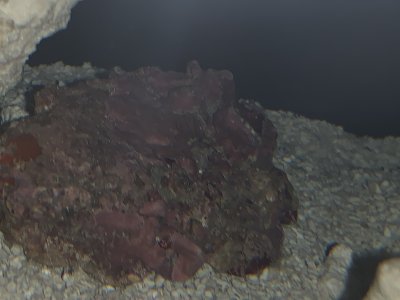TacticalDumb***
New member
Earlier this week my gulf rock came in from Tampa Bay Saltwater so what ever it is, it's from the Gulf of Mexico off the shore of Florida. I've been able to ID most of the hitchhikers but this one has me especially confused. It has a rather extreme aversion to light so getting good pictures and observing it in general has been a challenge.

There's the large one in the center and two to the left.
Getting any info on it has been challenging so I'm asking anywhere I can at This point. Some more info I've been able to gather through observation:
Like I mentioned earlier it has a rather extreme aversion to light. It is nocturnal and if you so much as shine a week light on it it will retract into the rock. I timed it and it takes about 1 minute for it to go from about 3/4in tall to being even with the rock, and another minute for it to be completely within the rock to the point you would never know its there unless you've seen it before (my current light is a Nicrew Marine LED so it's verry weak as reef lights go). I'm unsure as to how it is attached to the rock as its base is in a hole in the rock so I'm not sure if it has a soft base or a stony base. It doesn't get any energy from the photosynthesis and as to what it eats I don't know as I have yet to be able to see it eat due to its extreme light aversion. In the morning I dose phytoplankton for my filter feeders and crushed fish flakes (meat based) for my detritivores, and in the evening I just feed the crushed fish flakes again right before lights out. So it could be eating one or both of those.
I've asked about this on other platforms and people have suggested aptasia but I don't think this is aptasia as I've never heard of aptasia that actively avoids light.
There's the large one in the center and two to the left.
Getting any info on it has been challenging so I'm asking anywhere I can at This point. Some more info I've been able to gather through observation:
Like I mentioned earlier it has a rather extreme aversion to light. It is nocturnal and if you so much as shine a week light on it it will retract into the rock. I timed it and it takes about 1 minute for it to go from about 3/4in tall to being even with the rock, and another minute for it to be completely within the rock to the point you would never know its there unless you've seen it before (my current light is a Nicrew Marine LED so it's verry weak as reef lights go). I'm unsure as to how it is attached to the rock as its base is in a hole in the rock so I'm not sure if it has a soft base or a stony base. It doesn't get any energy from the photosynthesis and as to what it eats I don't know as I have yet to be able to see it eat due to its extreme light aversion. In the morning I dose phytoplankton for my filter feeders and crushed fish flakes (meat based) for my detritivores, and in the evening I just feed the crushed fish flakes again right before lights out. So it could be eating one or both of those.
I've asked about this on other platforms and people have suggested aptasia but I don't think this is aptasia as I've never heard of aptasia that actively avoids light.




